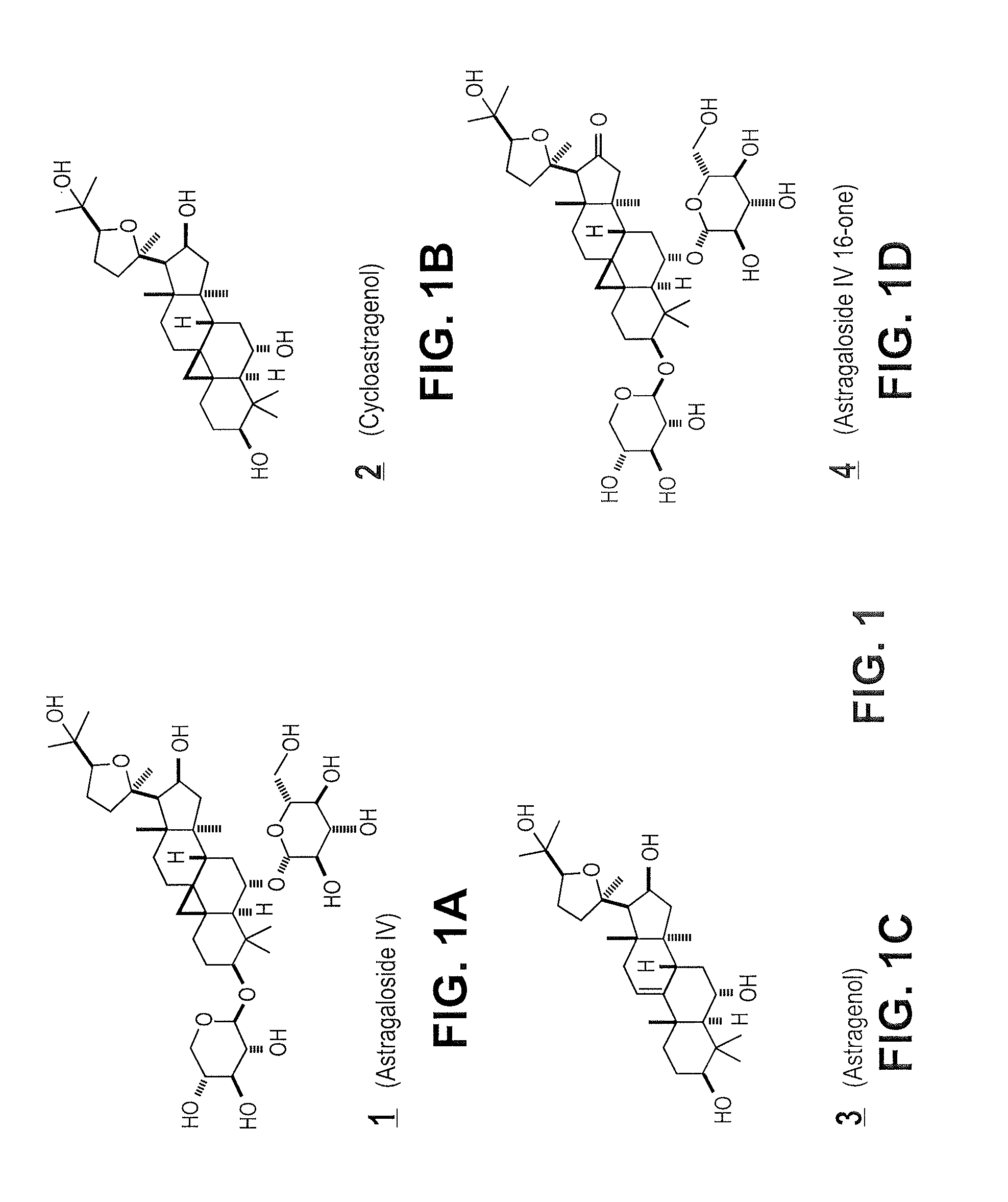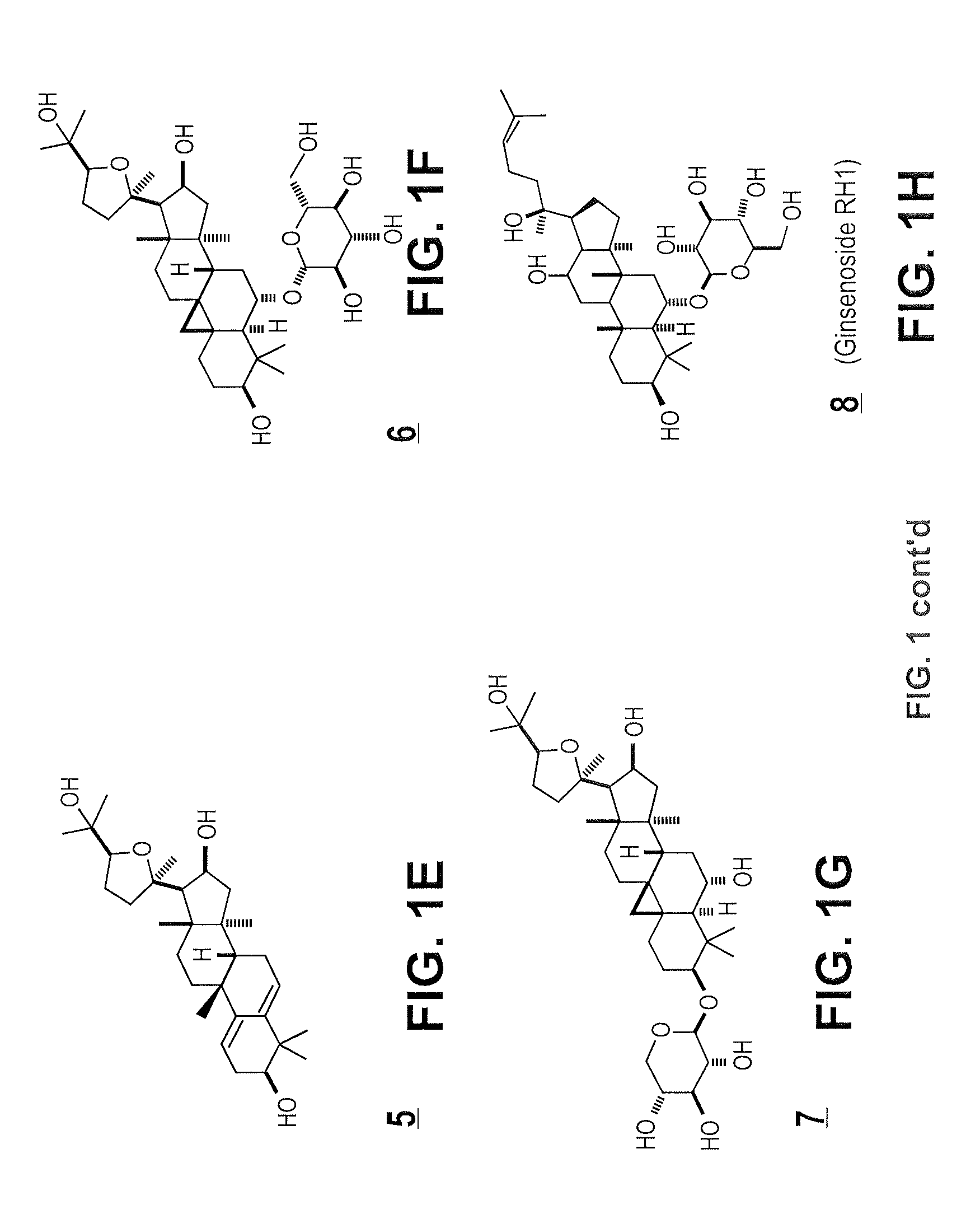Compositions and Methods for Increasing Telomerase Activity
a technology of telomerase activity and composition, which is applied in the direction of organic active ingredients, sugar derivatives, plant/algae/fungi/lichens ingredients, etc., can solve the problems of cell telomerase crisis, premature cell senescence, cell senescence, etc., and achieve the enhancement of replicative capacity and/or life span, and the effect of increasing telomerase activity
- Summary
- Abstract
- Description
- Claims
- Application Information
AI Technical Summary
Benefits of technology
Problems solved by technology
Method used
Image
Examples
example 1
Conversion of astragaloside IV (1) to cycloastragenol (2)
[0235]
[0236]To astragaloside IV (1) (5.00 g, mmol) was added “HCl-MeOH 10” (TCl America) (500 mL) and the mixture was stirred at room temperature for 7 days. The reaction mixture was concentrated to about half volume under reduced pressure at 20° C. (do not heat). The mixture was partitioned into aqueous sodium bicarbonate and ethyl acetate. The aqueous layer was extracted with ethyl acetate again. The organic layers were combined, washed with saturated sodium chloride, dried on anhydrous sodium sulfate, and concentrated under reduced pressure. The residue was purified by column chromatography (20:1˜14:1 chloroform / methanol). In order to replace the residual solvent with ethanol, the purified material was dissolved in ethanol and the solvent was removed under reduced pressure to afford 2 (2.1 g, 64%).
[0237]1H NMR (CDCl3) δ (ppm) 0.34 (d, J=4.7 Hz, 1H), 0.48 (d, J=4.3 Hz, 1H), 0.92 (s, 3H), 0.93 (s, 3H), 1.0-1.8 (m, 13H), 1.11 ...
example 2
Preparation of compounds 5, 6 and 7 from astragaloside IV (1): Removal of glycosides from astragaloside IV (1), with and without concomitant rearrangement
[0238]
[0239]To a solution of astragaloside IV (1, 1.00 g, 1.28 mmol) in methanol (80 mL) was added sulfuric acid (0.4 mL), and the mixture was refluxed for 1.5 h. After cooling to room temperature, the mixture was poured into ethyl acetate and water. The organic layer was washed with brine and dried on anhydrous sodium sulfate. The solvent was removed under reduced pressure, and the residue was purified by silica gel column chromatography (20:1˜10:1˜7:1 chloroform / methanol) to afford the rearranged product 5 (24 mg, 4.0%), monoglycosides 6 (172 mg, 21%) and 7 (29 mg, 3.6%) and the aglycone, cycloastragenol (2) (326 mg, 52%).
[0240]GRN140724: ESI-MS m / z 623 (M+H)+ C35H58O9=622
[0241]GRN140725: ESI-MS m / z 653 (M+H)+ C36H60O10=652
[0242]GRN 140726: ESI-MS m / z 473 (M+H)+ C30H48O4=472.
[0243]1H NMR (400 MHz, CDCl3) δ (ppm) 0.72, 0.85, 0.95,...
example 3
Acetylation of 1; formation of 16-ketone 10
[0244]Compounds 9 and 10, below, were obtained according to the method of Kitagawa 1983b, cited above. Briefly, acetylation of astragaloside IV (1) provided 9, together with a smaller amount of the 16-acetate counterpart. Pyridinium chlorochromate oxidation of 10 9 gave 10.
PUM
 Login to View More
Login to View More Abstract
Description
Claims
Application Information
 Login to View More
Login to View More - R&D
- Intellectual Property
- Life Sciences
- Materials
- Tech Scout
- Unparalleled Data Quality
- Higher Quality Content
- 60% Fewer Hallucinations
Browse by: Latest US Patents, China's latest patents, Technical Efficacy Thesaurus, Application Domain, Technology Topic, Popular Technical Reports.
© 2025 PatSnap. All rights reserved.Legal|Privacy policy|Modern Slavery Act Transparency Statement|Sitemap|About US| Contact US: help@patsnap.com



